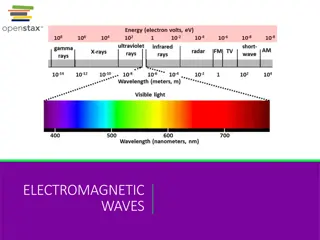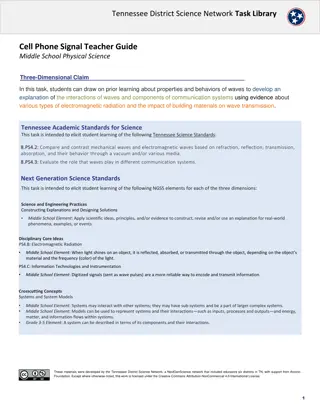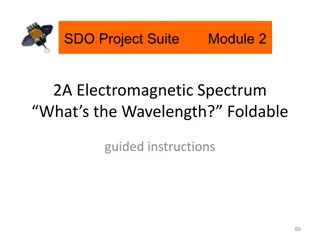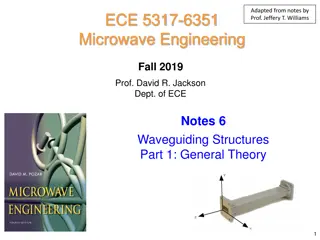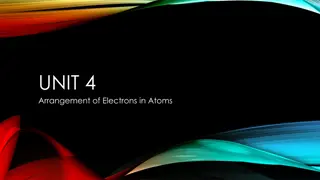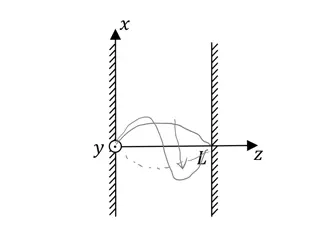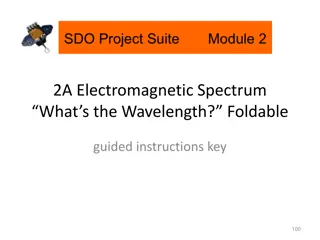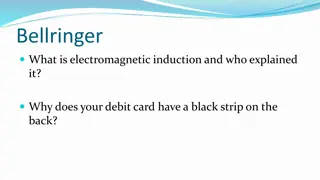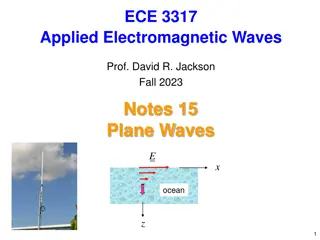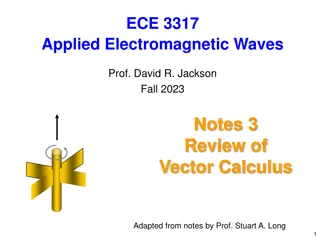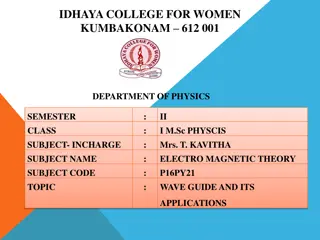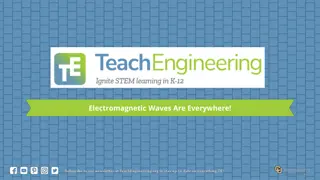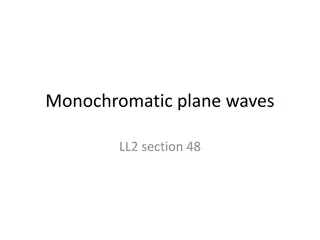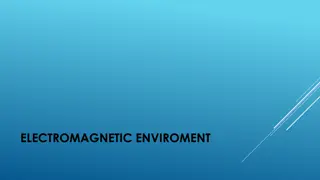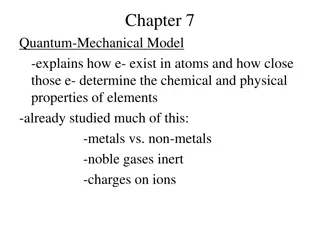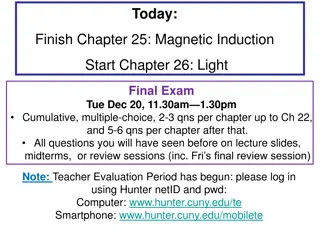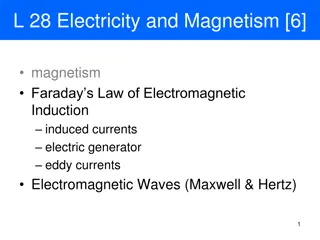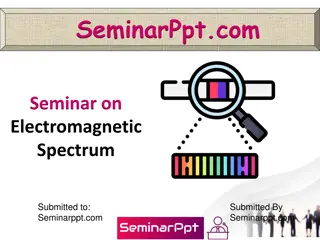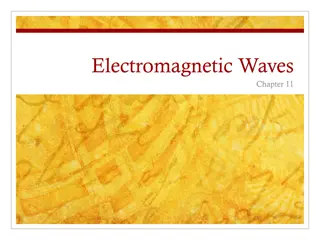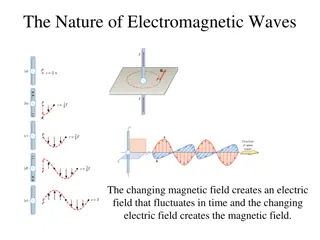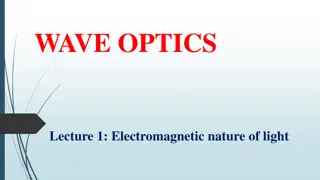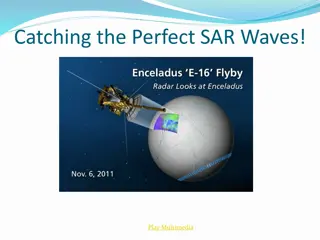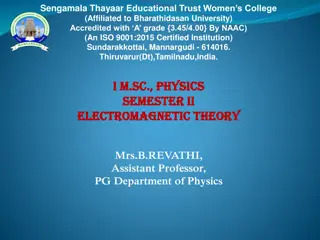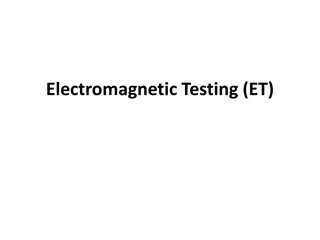Understanding Electromagnetic Waves: Maxwell's Contributions and Hertz's Observations
James Clerk Maxwell's groundbreaking work in the 19th century revealed the fundamental nature of light as an electromagnetic wave. His equations formed the basis for understanding the interplay between electricity and magnetism, predicting the existence of electromagnetic waves. Heinrich Hertz furth
4 views • 24 slides
ECE 305 Electromagnetic Theory
Explore the fundamental concepts of electric fields in material space, covering topics such as free space, conductors, insulators, semiconductors, current conduction, and charge density. Delve into the properties of materials, convection vs. conduction current, and the role of superconductors in ele
1 views • 25 slides
Electromagnetic Surveying Methods and Applications
Electromagnetic surveying, conducted by Dr. Laurent Marescot, utilizes various methods like resistivity, induced polarization, and high-frequency techniques for exploration and investigation purposes. The electromagnetic method involves generating primary fields and detecting secondary fields to ana
2 views • 55 slides
Exploring Types of Waves and Energy Transport
Discover the various types of waves such as transverse, longitudinal, surface, and electromagnetic waves, along with their characteristics and applications in energy transportation. Learn about the differences between mechanical and electromagnetic waves, how waves transmit energy, and their signifi
3 views • 10 slides
Evolution of Mathematical Theories and Proof Systems
Development of mathematical theories such as model theory, proof theory, set theory, recursion theory, and computational complexity is discussed, starting from historical perspectives with Dedekind and Peano to Godel's theorems, recursion theory's golden age in the 1930s, and advancements in proof t
1 views • 29 slides
Understanding Waves and Communication Systems in Middle School Science
Task designed for middle school students to explore properties of waves, electromagnetic radiation, and their role in communication systems. Incorporates Tennessee and NGSS standards, focusing on constructing explanations and modeling systems' interactions. Suggestions for classroom use provided to
1 views • 15 slides
Understanding Electromagnetic Spectrum Wavelengths: A Foldable Guide
Explore the Electromagnetic Spectrum through a foldable activity that involves identifying wavelengths, comparing sizes, learning about frequency, and examples of EM waves. Discover radio waves, microwaves, infrared rays, and visible light wavelengths in an interactive way.
0 views • 11 slides
Understanding Waveguiding Systems and Helmholtz Equation in Microwave Engineering
Waveguiding systems are essential in confining and channeling electromagnetic energy, with examples including rectangular and circular waveguides. The general notation for waveguiding systems involves wave propagation and transverse components. The Helmholtz Equation is a key concept in analyzing el
2 views • 50 slides
Understanding Electromagnetic Radiation and its Properties
This educational content delves into the arrangement of electrons in atoms, focusing on the properties of light and the electromagnetic spectrum, including the visible light spectrum. It explains wavelike behavior, wavelength, frequency, and their mathematical relationship, providing practice questi
0 views • 39 slides
Understanding Quantum Aspects of Electromagnetic Oscillations
Exploring the quantum nature of electromagnetic oscillations through concepts such as wave-particle duality, quantum harmonic oscillators, photon-number states, coherent light, and squeezed light. Delve into non-classical states, vacuum states, potential wells, and more in the fascinating world of q
1 views • 15 slides
Exploring the Electromagnetic Spectrum with Wavelengths Foldable
Explore the Electromagnetic Spectrum through a guided foldable activity that involves researching and labeling different wavelengths, comparing sizes, identifying longest and shortest waves, understanding frequencies, and providing examples of wavelengths from various sources such as radio broadcast
0 views • 13 slides
Understanding X-Ray Radiation: A Comprehensive Overview
X-ray radiation, discovered by Wilhelm Conrad Roentgen in 1895, is a high-energy electromagnetic radiation with a frequency range of 3.10^16Hz to 3.10^19Hz and a corresponding wavelength range from 0.01nm to 10nm. This form of radiation has applications in various fields, and its properties make it
0 views • 15 slides
Understanding the Theory of Firms: Neoclassical vs. Modern Approaches
The theory of firms is explored through the Neoclassical and Modern perspectives. Neoclassical theory focuses on profit maximization, while Modern theory delves into managerial, principal-agent, and transaction cost theories. The discussion covers criticisms of Neoclassical theory and the essential
1 views • 79 slides
Understanding Waves: A Visual Exploration
Explore the fascinating world of waves through visually engaging images and interactive clickers. Learn about different types of waves, including longitudinal and transverse waves, and discover what waves carry - energy, not matter. Delve into the concepts of mechanical and electromagnetic waves, an
1 views • 37 slides
Understanding UV/Visible Spectroscopy and Electromagnetic Radiation
Spectroscopy is the study of the interaction of matter with light, specifically UV and visible radiation. Electromagnetic radiation, consisting of photons, transmits energy through space as waves with oscillating electric and magnetic fields. The relationship between wavelength and frequency is key,
0 views • 50 slides
Understanding Energy Transformation in the Natural World
Energy transformation occurs continuously in various forms around us, following the Law of Conservation of Energy. From thermal to chemical and electromagnetic energy, different types of energy are converted and utilized in everyday processes. Examples include the conversion of thermal energy to ele
0 views • 27 slides
Understanding Electromagnetic Induction and Wave Characteristics
Explore the concept of electromagnetic induction, its explanation by scientists, and the presence of a black strip on your debit card. Discover the basic characteristics of waves, including amplitude, crest, trough, wavelength, phase, frequency, and speed. Dive into the world of waves and their ener
0 views • 99 slides
Understanding Electromagnetic Waves: A Comprehensive Overview
Introduction to plane waves, the electromagnetic spectrum, TV and radio spectrum, and a comparison of wired and wireless systems. Discusses the properties and applications of various frequency ranges within the electromagnetic spectrum. Highlights the efficiency of wireless systems over wired system
0 views • 37 slides
Managing Electromagnetic Fields in the Workplace: Regulations and Guidelines
James Gray, an experienced Radiation Protection Adviser, provides insights on the Control of Electromagnetic Fields at Work Regulations. The content covers definitions, health effects, direct and indirect effects, and necessary actions to ensure workplace safety regarding EMFs exposure.
0 views • 19 slides
Overview of Vector Calculus for ECE 3317 Course
This overview provides a brief explanation of vector calculus concepts essential for the ECE 3317 course on Applied Electromagnetic Waves. It covers del operator, gradient, divergence, curl, vector Laplacian, vector identities, and their applications in electromagnetic field theory.
0 views • 24 slides
Evolution of Light Theory: From Wave Theory to Quantum Theory
At the turn of the century, the discovery of the photoelectric effect challenged the wave theory of light, leading to the development of the quantum theory by Max Planck and Albert Einstein. This new theory introduced the concept of discrete energy units known as quanta, bridging the gap between wav
1 views • 62 slides
Understanding Waveguides in Electromagnetic Theory
The concept of waveguides in electromagnetic theory involves the transmission of electromagnetic waves through hollow metallic tubes, such as rectangular and circular waveguides made from materials like copper and aluminum. These waveguides support different modes of propagation, including TE, TM, a
6 views • 15 slides
Unveiling the World of Electromagnetic Waves
Delve into the omnipresence of electromagnetic radiation with engaging activities that explore the characteristics of the electromagnetic spectrum, devices utilizing electromagnetic waves, and the mechanisms behind their functionality. Enhance your understanding by partaking in interactive learning
0 views • 7 slides
Understanding General Plane Waves in Electromagnetic Theory
This study focuses on the analysis of general plane waves in electromagnetic theory, covering topics such as the general form of plane waves, Helmholtz equation, separation equation, wavenumber vector, Maxwell's equations for plane waves, and the symbolic representation of plane waves. The content d
0 views • 41 slides
Understanding Monochromatic Plane Waves in Electromagnetic Theory
Explore the characteristics and properties of monochromatic plane waves in electromagnetic theory, including their spatial distribution, propagation in the positive X direction, wavelength, linear and non-linear operations, polarization direction, elliptical and circular polarization, and the relati
0 views • 15 slides
Understanding the Wave Theory of Light and Electromagnetic Spectrum
Explore the fascinating world of electromagnetic waves, visible light, and the wave theory through concepts such as wavelength, frequency, amplitude, and the speed of light. Understand how these elements are interconnected, and discover the diverse range of the electromagnetic spectrum. Dive into th
0 views • 77 slides
Understanding Waves: Characteristics and Types Explained
Explore the wave nature of sound and electromagnetic radiation, distinguishing between electromagnetic and mechanical waves. Waves are energy-carrying disturbances that do not transport matter. Mechanical waves require a medium for energy transfer, while electromagnetic waves can travel through spac
0 views • 26 slides
Understanding Harmonics in Electromagnetic Environments
In the realm of electromagnetic environments, the generation of electromagnetic interference (EMI) through harmonics plays a crucial role. This article delves into the concept of harmonics, their generation in simple DC power supplies, and the impact they have on electronic devices. From the basics
0 views • 31 slides
Understanding Quantum-Mechanical Model and Electromagnetic Waves
Quantum-Mechanical Model delves into how electrons exist in atoms, shaping the chemical and physical properties of elements. It contrasts metals and non-metals, emphasizes noble gases' inertness, and explains the charges on ions. Additionally, it explores the similarities between electrons and light
0 views • 33 slides
Theories of Interest in Microeconomics II
Explore various theories of interest in economics, including the Classical Theory, Liquidity Preference Theory by Keynes, Productivity Theory, Abstinence Theory, Time-Preference Theory, Fisher's Time Preference Theory, and the Loanable Fund Theory. These theories offer different perspectives on the
0 views • 6 slides
Understanding Electromagnetic Waves and Their Velocity
Light, as a transverse wave, is a part of the electromagnetic spectrum produced by accelerating electrons. Electromagnetic waves originate from vibrating charges, creating a continuous cycle of electric and magnetic fields. The velocity of electromagnetic waves is constant due to energy conservation
0 views • 32 slides
Understanding Magnetism: Faraday's Law and Electromagnetic Induction
Explore the fascinating world of magnetism and electromagnetism with insights into Faraday's Law of Electromagnetic Induction, induced currents, and the basic principles of magnetism. Discover how a changing magnetic field can produce a current and unravel the key concepts behind electromagnetic wav
0 views • 24 slides
Understanding Spectrometry and Electromagnetic Waves
Spectrometry plays a vital role in analytical chemistry by studying the interactions of radiation and matter through electromagnetic waves. These waves, characterized by varying electric and magnetic fields, travel at the speed of light in vacuum with a constant velocity. The properties and characte
0 views • 24 slides
Understanding the Electromagnetic Spectrum: A Comprehensive Overview
The electromagnetic spectrum encompasses a vast range of frequencies and wavelengths of electromagnetic radiation. This seminar presentation delves into the definition, uses, significance, and formulas associated with the electromagnetic spectrum. Covering topics from radio waves to cosmic rays, it
0 views • 20 slides
Understanding Electromagnetic Waves: Essential Concepts and Applications
Electromagnetic waves are a fundamental aspect of physics, characterized by the transmission of energy through vibrating electric and magnetic fields. This comprehensive guide explores the production, properties, and applications of electromagnetic waves, shedding light on topics such as photon beha
0 views • 21 slides
Understanding Electromagnetic Waves: Speed, Spectrum, and Applications
Electromagnetic waves are characterized by the interplay between changing magnetic and electric fields, propagating at the speed of light in a vacuum. This speed, denoted by 'c,' is a fundamental constant. The electromagnetic spectrum encompasses a range of frequencies and applications, from radio a
0 views • 12 slides
Understanding the Electromagnetic Nature of Light in Wave Optics
Exploring the electromagnetic properties of light, this lecture covers the dual nature of light as both a wave and particles, the quantized particle nature of light known as photons, and the manifestation of the electromagnetic nature of light through Maxwell's equations. It delves into wavefronts,
0 views • 8 slides
Understanding Electromagnetic Waves and Radar Systems
Dive into the world of electromagnetic waves and radar systems with detailed explanations on wave basics, the electromagnetic spectrum, radar technology, and applications in geometry. Discover how radio waves are used in radar systems and the importance of electromagnetic energy in modern engineerin
0 views • 13 slides
Understanding Electromagnetic Waves in Physics
Exploring the propagation of electromagnetic waves in different mediums such as free space and isotropic dielectrics. Discusses Maxwell's equations, wave equations, transverse nature, energy transmission, and impedance in electromagnetic wave propagation.
0 views • 24 slides
Understanding Electromagnetic Testing (ET) in NDT
Electromagnetic Testing (ET) is a crucial NDT method involving techniques like Eddy Current Testing (ECT) and Alternating Current Field Measurement (ACFM). It is used for crack detection, material thickness measurement, and more in various industries due to its sensitivity and immediate results. Des
0 views • 21 slides
